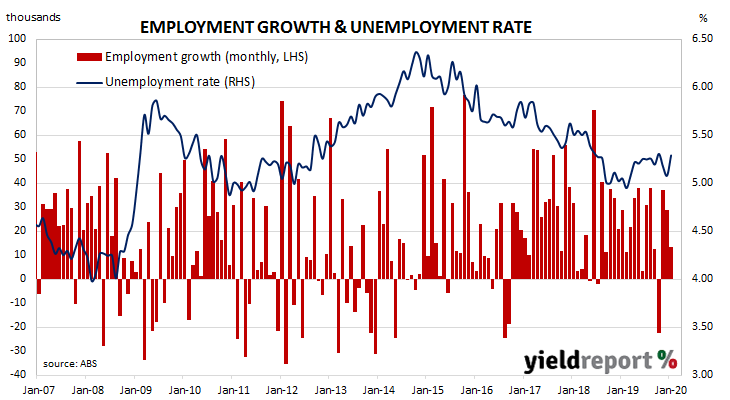Australia’s period of falling unemployment came to an end in early 2019 when the jobless rate hit a low of 4.9%. Since then, it has averaged around 5.2%, bouncing around in a range which extends from 5.1% to 5.3%. Recent leading indicators have been generally pointing towards further softness and the RBA is still generally expected to reduce its cash rate target in the second half of 2020, a move Philip Lowe has recently said would only occur should the unemployment rate trend “in the wrong direction”.
The latest Labour force figures have now been released and they indicate the number of people employed in Australia increased by more than economists had expected. The report showed the total number of people employed in Australia increased by 13,500 in January, while the unemployment rate worsened from 5.1% to 5.3%.
ANZ senior economist Felicity Emmett said, “The RBA has been clear in its focus on the labour market as a key barometer of the health of the economy. It would be disappointed by the lift in the unemployment rate in January, but would likely characterise it as broadly stable at 5.25%.”
Westpac senior economist Andrew Hanlan took a less charitable line. “The January labour force survey in detail and tone was broadly in keeping with our reading of the economy and [it] calls into question the RBA’s optimism.” Market expectations prior to the report’s release were for 7,500 new positions to be created and for the unemployment rate to tick up to 5.2%. Investors and traders reacted to the figures by sending yields lower. By the end of the day, 90-day bank bills had shed 2bps to 0.89%, yields on 3-year and 10-year ACGBs had each lost 4bps to 0.68% and 1.00% respectively while the 20-year yield finished 3bps lower at 1.40%.
Market expectations prior to the report’s release were for 7,500 new positions to be created and for the unemployment rate to tick up to 5.2%. Investors and traders reacted to the figures by sending yields lower. By the end of the day, 90-day bank bills had shed 2bps to 0.89%, yields on 3-year and 10-year ACGBs had each lost 4bps to 0.68% and 1.00% respectively while the 20-year yield finished 3bps lower at 1.40%.

